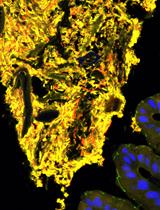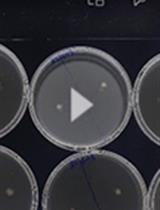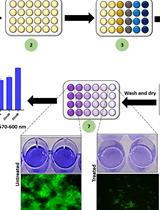- EN - English
- CN - 中文
Determination of NO and CSF Levels Produced by Bacillus subtilis
枯草芽孢杆菌生成的NO和CSF水平测定
发布: 2017年07月05日第7卷第13期 DOI: 10.21769/BioProtoc.2379 浏览次数: 9064
评审: Jyotiska ChaudhuriSanjib Kumar GuhaTugsan Tezil

相关实验方案

从沙门氏菌鼠伤寒血清中纯化细菌淀粉样蛋白“Curli”并检测受感染宿主组织中的 Curli
Murugesan Sivaranjani [...] Aaron P. White
2022年05月20日 3040 阅读
Abstract
The cell-to-cell communication and division of labour that occurs inside a beneficial biofilm produce significant differences in gene expression compared with the gene expression pattern of cells grew under planktonic conditions. In this sense, the levels of NO (nitric oxide) and CSF (Competence Sporulation Stimulating Factor) produced in Bacillus subtilis cultures have been measured only under planktonic growth conditions. We sought to determine whether NO and/or CSF production is affected in B. subtilis cells that develop as a biofilm. To measure the production levels of the two prolongevity molecules, we grew B. subtilis cells under planktonic and biofilm supporting condition.
Keywords: Bacillus subtilis (枯草芽孢杆菌)Background
NO is a key signalling molecule, playing a role in a variety of biological processes in vertebrates (Kerwin et al., 1995). C. elegans is unable to produce its own NO but is able to incorporate the NO produced by B. subtilis (Cabreiro and Gems, 2013; Gusarov et al., 2013; Kim, 2013; Clark and Hodgkin, 2014). Most organisms produce NO through aerobic conversion of L-arginine to L-citrulline in a reaction catalysed by the enzyme NO synthetase encoded by the nos gene (Sudhamsu and Crane, 2009). E. coli strains, several of which are routinely used to feed worms (OP50, HB101) (Cabreiro and Gems, 2013; Kim, 2013; Clark and Hodgkin, 2014), are not proficient in aerobic NO production because they lack a functional copy of nos (Sudhamsu and Crane, 2009). However, E. coli can produce NO under anaerobic/microaerophilic conditions by a series of biochemical reactions associated with the anaerobic respiratory chain of the bacterium (Corker and Poole, 2003). In such case, E. coli might find permissive conditions for NO production in the oxygen-depleted environment of the worm intestine. Bacteria produced-NO in worm gut that freely diffuses through the plasma membrane is oxidized to nitrate and nitrite, and thus, the concentration of nitrate and nitrite are directly proportional to the level of NO production (Gusarov et al., 2013) and can be determined using a colorimetric assay.
Intra- and interspecific quorum sensing (QS) constitutes molecules that bacteria use in nature to communicate with each other and with cells of different kingdoms (Shapiro, 1998; Ben Jacob et al., 2004; Parsek and Greenberg, 2005; Bassler and Losick, 2006). B. subtilis QS pentapeptide CSF (Competence Sporulation Stimulating Factor, also named PhrC) (Lazazzera et al., 1997) was previously reported to contribute to intestinal homeostasis by activating key survival pathways of the host (p38 MAP kinase and protein kinase B) and by inducing cytoprotective heat shock proteins (Hsps) (Fujiya et al., 2007; Willians, 2007). These effects of CSF (Willians, 2007) depend on its uptake by the protein OCTN2, a host cell membrane transporter of organic cations present in the apical face of epithelial cells (Fujiya et al., 2007). To quantify bacteria-produced CSF, promoters are commonly fused to heterologous reporter genes that encode enzymes that can be quantified using highly sensitive assays. Typically, incorporation to B. subtilis of a reporter lacZ gene, encoding β-galactosidase (β-gal) to the promoter region of a gene of interest, can be used to determine the level of CSF produced by this probiotic bacterium. When used in this manner, the Pcsf-lacZ fusion is integrated into the chromosome at the non-essential amyE locus. The basic colorimetric assay described here is the simplest and less expensive assay for quantifying β-gal activity. The cells are lysed and an aliquot of the extract is mixed with the reaction substrate, O-nitrophenyl-β-D-galactopyranoside (ONPG). When the yellow product becomes visible, the optical densities of the samples are determined spectrophotometrically.
Materials and Reagents
- Pipette tips
- Petri dishes 60 x 15 mm 500/cs (Fisher Scientific, catalog number: FB0875713A )
- Sterile 150 x 20 mm-culture tube (Sigma-Aldrich, catalog number: C1048 )
- Sterile 150 x 16 mm-culture tube (Science Lab Supplies, catalog number: 6135-5-012 )
- 1.5 ml tube
- Amicon Ultra 0.5 ml centrifugal filters MWCO 10 kDa (Sigma-Aldrich, catalog number: Z677108)
Manufacture: EMD Millipore, catalog number: UFC501096 . - Amicon Ultra centrifugal filter units Ultra-4, MWCO 30 kDa (Sigma-Aldrich, catalog number: Z648035)
Manufacture: EMD Millipore, catalog number: UFC803024 . - Cryovial (Simport, catalog number: T310-2A )
- 96-well solid plate (Colorimetric assay) (Cayman Chemical, catalog number: 400014 )
- 96-well cover sheet (Cayman Chemical, catalog number: 400012 )
- Derivative of B. subtilis NCIB31610
- Bacillus subtilis NCIB3610 and JH642 (Bacillus Genetic Stock Center, catalog numbers: 3A1 and 1A96 )
- Sodium chloride (NaCl) (Sigma-Aldrich, catalog number: S7653 )
- Bacto peptone (BD, BactoTM, catalog number: 211677 )
- Nitrate/Nitrite Colorimetric Assay Kit (Cayman Chemical, catalog number: 780001 )
- Nitrate/Nitrite assay buffer (Cayman Chemical, catalog number: 780022 )
- Nitrate Reductase Enzyme Preparation (Cayman Chemical, catalog number: 780010 )
- Nitrate Reductase Cofactor Preparation (Cayman Chemical, catalog number: 780012 )
- Nitrate Standard (Cayman Chemical, catalog number: 780016 )
- Griess Reagent R1 (Cayman Chemical, catalog number: 780018 )
- Griess Reagent R2 (Cayman Chemical, catalog number: 780020 )
- Luria Bertani broth (Sigma-Aldrich, catalog number: L3522 )
- Luria Bertani broth with agar (Sigma-Aldrich, catalog number: L2897 )
- Agar (Sigma-Aldrich, catalog number: A1296 )
- Potassium phosphate dibasic (K2HPO4) (Sigma-Aldrich, catalog number: P2222 )
- Potassium phosphate monobasic (KH2PO4) (Sigma-Aldrich, catalog number: P9791 )
- MOPS (Sigma-Aldrich, catalog number: M9381 )
- Magnesium sulfate heptahydrate (MgSO4·7H2O) (Sigma-Aldrich, catalog number: M1880 )
- Calcium chloride dihydrate (CaCl2·2H2O) (Sigma-Aldrich, catalog number: C3881 )
- Manganese(II) chloride (MnCl2·2H2O) (EMD Millipore, catalog number: 1059340100 )
- Glycerol (Sigma-Aldrich, catalog number: G5516 )
- Iron(III) chloride hexahydrate (FeCl3·6H2O) (Sigma-Aldrich, catalog number: 236489 )
- Glutamate (Sigma-Aldrich, catalog number: 49621 )
- Tryptophan (Sigma-Aldrich, catalog number: T0254 )
- Phenylalanine (Sigma-Aldrich, catalog number: P2126 )
- Chloramphenicol (Sigma-Aldrich, catalog number: C0378 )
- 100% ethanol (Sigma-Aldrich, catalog number: E7023 )
- Cholesterol (Sigma-Aldrich, catalog number: C8667 )
- Sodium phosphate dibasic (Na2HPO4) (Sigma-Aldrich, catalog number: S3264 )
- Sodium phosphate monobasic (NaH2PO4) (Sigma-Aldrich, catalog number: S3139 )
- Potassium chloride (KCl) (Sigma-Aldrich, catalog number: P9541 )
- β-mercaptoethanol (Sigma-Aldrich, catalog number: M6250 )
- Lysozyme from chicken egg white (Sigma-Aldrich, catalog number: L6876 )
- Triton X-100 (Sigma-Aldrich, catalog number: X100 )
- O-nitrophenyl-β-D-galactopyranoside (Sigma-Aldrich, catalog number: N1127 )
- Sodium carbonate (Na2CO3) (Sigma-Aldrich, catalog number: 223484 )
- 10 N NaOH
- Nematode growth medium (NGM) broth (see Recipes)
- MSgg medium (see Recipes)
- 5 mg/ml chloramphenicol (see Recipes)
- 5 mg/ml cholesterol (see Recipes)
- 1 M MgSO4 (see Recipes)
- 1 M CaCl2 (see Recipes)
- Phosphate buffer (see Recipes)
- Z buffer (see Recipes)
- 10 mg/ml lysozyme solution (see Recipes)
- 10% Triton X-100 solution (see Recipes)
- O-nitrophenyl-β-D-galactopyranoside (ONPG) 4.5 mg/ml (see Recipes)
- 1.2 M Na2CO3 (see Recipes)
- 50% glycerol (see Recipes)
- 100 mM MOPS pH = 7 (see Recipes)
Equipment
- Erlenmeyer flask (Fisher Scientific, catalog number: FB5006000 )
- Pipettor (Gilson, catalog number: F167300 )
- Glass pipette
- Refrigerated incubator (Thermo Fisher Scientific, Thermo ScientificTM, catalog number: 51028064 ; Fisher Scientific, catalog number: 37-20 )
Note: The product “Fisher Scientific, catalog number: 37-20 ” has been discontinued. - Water bath (AQUA® LYTIC incubator 37 °C)
- Freezers (-20 °C; So-Low Environmental Equipment) (Siemens, model: So-Low Ultra C85-22 )
- Autoclave (Tuttnauer, model: Model 6690 )
- Stirring hotplate (Corning, catalog number: 6795-620 )
- Centrifuge (Eppendorf, model: 5430 )
- Tabletop centrifuge (Eppendorf, model: 5424 )
- Molecular Dynamics Model SpectraMAX 340 PC microplate reader (Molecular Devices, model: SpectraMAX 340PC384 )
Procedure
文章信息
版权信息
© 2017 The Authors; exclusive licensee Bio-protocol LLC.
如何引用
Cogliati, S., Rodriguez Ayala, F., Bauman, C., Bartolini, M., Leñini, C., Villalba, J. M., Argañaraz, F. and Grau, R. (2017). Determination of NO and CSF Levels Produced by Bacillus subtilis. Bio-protocol 7(13): e2379. DOI: 10.21769/BioProtoc.2379.
分类
微生物学 > 微生物信号传导 > 第二信使
微生物学 > 微生物生物膜 > 生物膜培养
您对这篇实验方法有问题吗?
在此处发布您的问题,我们将邀请本文作者来回答。同时,我们会将您的问题发布到Bio-protocol Exchange,以便寻求社区成员的帮助。
提问指南
+ 问题描述
写下详细的问题描述,包括所有有助于他人回答您问题的信息(例如实验过程、条件和相关图像等)。
Share
Bluesky
X
Copy link


















